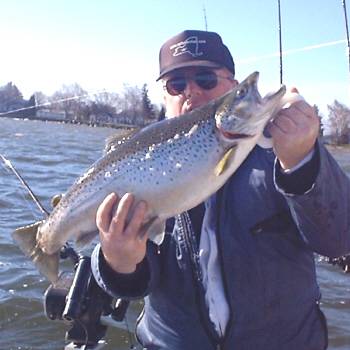 |

|

|
 |

|

|
|
April 21, 2005 Raymond Martin from Elmira NY was fishing on Lake Ontario aboard the BUC-A-ROO. The fishing was simply fantastic. Here is a 14 pound Brown Trout taken on a stickbait off a planer board in 7 feet of water. The catch was comprised of brown trout from 5 to 14 pounds a nice 5 pound rainbow and Coho Salmon from 4 to 8 pounds. The fish were in great shape and seem to be eating very well. Several of the fish were later found to have been feeding heavily on Round Gobies 4 to 6 inches in length. |

|
|
Round Gobies are native to the Black and Caspian seas. They average in size from 4 to 10 inches. Sometime in the early 1990's it is thought that they were transported and released into the Great Lakes accidentally from the ballast water of ships traveling from Eurasia. Round Gobies also are capable of rapid population growth. They spawn repeatedly during the spring and summer from April through September. They have the ability to survive in poor water quality conditions. They can feed in complete darkness. Larger gobies have been found to feed heavily on zebra mussels. This and the fact that they are being targeted as food by our native fish is encouraging, but the effects of exotic invaders can and will alter the food chain from the top to the bottom. |
|
The key to great spring fishing is to find the stained water along the shoreline. Using planner boards run brightly colored stickbaits in orange, red, yellow and pink color combinations into the darker water, and on the clear side run darker colored lures in black, silver, green, and blue. Also try different size plugs to match the size of the baitfish they may me feeding on. Sometimes it may be necessary to add a small split shot a few feet in front of the stickbait to get the plug down if the stained water carries out to water a depth of more than 15 feet deep. You may also run a spoon or stickbait on flat line behind the boat as well. Fish may be taken with down riggers set 2 to 6 feet deep with a long lead say 30 to 60 feet back. When using down riggers in close pay attention to the water depth so you don't hang them up on the bottom. |
|
|

|
|
|
|
|
|